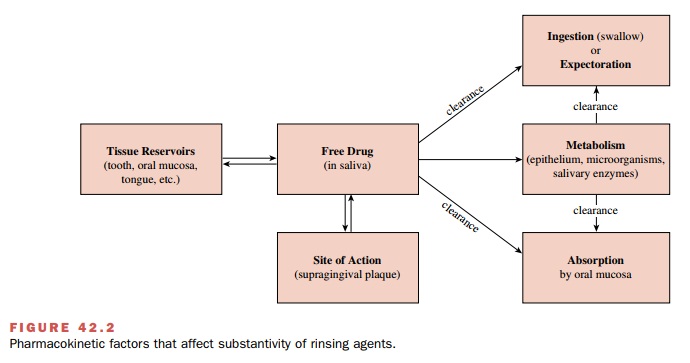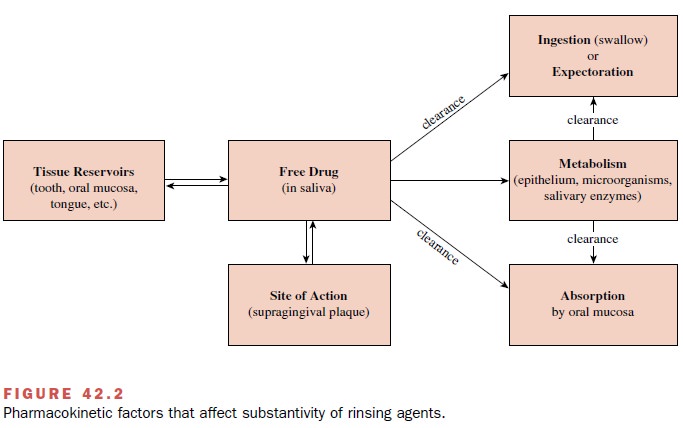Chapter: Modern Pharmacology with Clinical Applications: Drugs for the Control of Supragingival Plaque
Pharmacokinetics of the Oral Cavity

PHARMACOKINETICS
OF THE ORAL CAVITY
The therapeutic outcome of
topically applied agents used to control oral infections will depend on the
char-acteristics of drugs that take advantage of the unique physiological and
anatomical circumstances in the oral cavity. This section is a broad overview
of important oral pharmacokinetic principles.
Absorption
The vascularity of the oral cavity,
combined with a thin epithelial lining in some areas, allows for the absorption
of drugs at a rapid rate. Un-ionized drugs, such as nitro-glycerin, take
advantage of these tissue characteristics and diffuse rapidly across the oral
mucosa into the bloodstream. Unlike most drugs, for which the principal
objective is to introduce the agent into the bloodstream rapidly, the goal of
oral topical agents is to be retained in the oral cavity for as long as
possible. Absorption can lead to toxic effects elsewhere in the body and a
signif-icant reduction of the free drug in the oral cavity. In most instances,
the drugs used to restrain plaque levels are highly ionized and therefore are
generally unable to penetrate the oral mucosa.
Distribution
Once an agent is topically
applied in the oral cavity, the free drug can act at the primary site (i.e.,
bacteria in the plaque), or it can be partitioned to compartments where the
drug binds nonspecifically. These drug reservoirs in-clude the enamel, dentin,
and/or cementum of the tooth, the oral mucosa, the organic and inorganic
com-ponents of plaque, and salivary proteins.
The fraction of the
administered dose that is non-specifically bound to oral reservoirs is highly
dependent on the drug’s concentration and chemical nature and the amount of
time it remains at the site. For example, a 1-minute rinse with 0.2%
chlorhexidine will result in approximately 30% of the total amount dispensed
be-ing retained, whereas a 3-minute rinse with 0.1% sodium fluoride will result
in less than 1% of the ad-ministered dose being found in the oral cavity after
an hour. The ability of oral agents to bind to oral reservoirs nonspecifically
and reversibly is an important quality for sustained release of drugs.
Metabolism
In the oral cavity, drug
metabolism occurs in mucosal epithelial cells, microorganisms, and enzymes in
the saliva; metabolism also takes place in renal and hepatic tissue once the
drug is swallowed. Although biotrans-formation of agents in the oral cavity is
potentially an important aspect of reducing effective drug concentra-
tions, quantitatively it
accounts for only a small per-centage of drug inactivation.
Excretion
Salivary flow is extremely
important in the removal of many agents from the oral cavity. Human saliva has
a diurnal flow that varies between 500 and 1,500 mL in the daytime to less than
10 mL of secretion at night. The rate of clearance of a drug from the oral
cavity there-fore is profoundly important in determining the amount of time a
drug is in contact with the tooth surface.
Substantivity
The period that a drug is in
contact with a particular sub-strate in the oral cavity is substantivity. Drugs that have a prolonged duration of contact are
considered to have high substantivity. In the oral cavity, substantivity
de-pends on two important pharmacokinetic features: the degree of reversible
nonspecific binding to oral reser-voirs and the rate of clearance by salivary
flow (Fig. 42.2).

Oral reservoirs are an
important source for the con-tinued release of drugs. The oral compartments
that ac-cumulate a drug must reversibly bind large portions of the administered
dose and release therapeutic concen-trations of free drug to the site of action
over long peri-ods. Therefore, effective agents with high substantivity ideally
would not bind irreversibly, nor would they bind with high affinity to oral
reservoirs.
Salivary flow also will
significantly affect the sub-stantivity of topically applied liquid agents. The
clear-ance of an agent from the oral cavity is directly propor-tional to the
rate of salivary flow. Hence, during periods of high salivary flow, a greater
release of drug from oral reservoirs is necessary to maintain therapeutic
concen-trations. Strategies that use natural or drug-induced pe-riods of low
salivary flow can increase the substantivity of an oral agent.
Related Topics